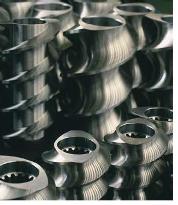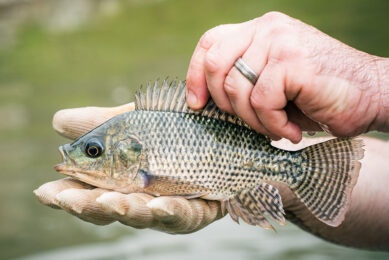Twin screw extruders were first used in the 1950s for manufacturing of thermoplastics. Only since the 1970s have these machines been used for feed and food products. Twin screw extruders (TSE) can be classified by their mechanical way of working into co-rotating (both screws turn same direction) and counter rotating (one screw turns right and the other turns left) and the screw configuration into intermeshing self wiping and non-intermeshing. A TSE compared to a single screw extruder has a much wider operating range in terms of use of moisture, internal fat, mechanical energy input and product size.
Extruded aquatic feeds have several qualities. Looking at the physical properties, with TSE the shape of the final pellet can be adapted to the animal’s mouth and calibration of shape and size is easy. A TSE can influence the texture of the pellet varying in hardness, brittleness, cohesiveness, etceteras. Density can also be influenced, resulting in sinking and floating properties adjusted to the fish’s eating behaviour. Finally storage and handling abilities can be influenced regarding fines content and moisture content amongst others.
The biological properties of aquatic feeds are much easier to match with the animal’s needs when a TSE is used. Recipes can be adapted to physiological needs and depending on species and age. Availability of nutrients can be improved when using TSE and extrusion has a significant effect on protein. This protein can originate from plant sources such as soybeans, legumes, glutens and cereal grains. These have good functional properties, relatively low cost, but amino acid profiles may sometimes be lacking some essentials. Furthermore glutens and cereal grains are excellent
binders and expand well. Proteins from animal sources such as meat, fish, blood and gelatine have poor functional properties unless they are fresh or spray dried. Costs are usually higher compared to plant proteins, but amino acid profiles are good. Proteins cannot be processed at a too high temperature (>150°C) since this will damage the protein and make it indigestible for the animal.
Three stage process
The fish feed extrusion process can be divided into three stages:
1. Preconditioning
2. Thermomechanical cooking
3. Texturisation
Preconditioning aims at prehumidifying and preheating the raw materials. Some precooking of starch occurs. This allows increasing thermal energy input in the mix and decreasing mechanical energy in the extruder. Preconditioning increases extruder productivity and decreases the rate of wear. In general a preconditioner should have a filling ratio of 50% and a residence time of 2-4 minutes. Precooked mix temperature is 90°C and precooked mix moisture is between 20-23%.
The thermomechanical cooking is of course the main stage in extruding aquafeeds. A co-rotating TSE is a positive displacement pump (Figure 1), thanks to the interpenetration of the screws. This allows handling viscous, oily, sticky or very wet materials, with the same level of pumping efficiency. There is an extended choice of raw materials when using a corotating TSE. A TSE has a high tolerance to lipids in raw materials and formulations.
In a co-rotating TSE, throughput and screw speed are decoupled. Then, for a given formulated feed mix, a co-rotating TSE is characterised by multiple operating points and screw profiles can vary extensively to modulate the mechanical energy input.
In a co-rotating TSE very intense mixing is observed in the intermeshing zone of the screws where macromixing and micromixing occurs (Figure 2). Consequently, heat transfer coefficient in the fully filled sections is high. Homogeneous melts can be obtained with very good lipid binding. Die expansion develops consistently, which leads to constant product density, texture and shaping as well as a uniform product colour.
Process parameters
Extrusion is a process of thermomechanical cooking, with the two main energy inputs being temperature and mechanical energy. To optimally use these inputs the design of the TSE is of importance regarding screw diameter, screw length/diameter ratio and screw profile. Operating conditions that influence the cooking process are mix feed rate, water flow rate, steam flow rate, screw speed and temperature profile. The final product then is determined by die texturisation, which is managed by the shape of the inserts, the opening section, air gap and die plate design.
Obviously the screw pattern of the TSE is important in obtaining the desired product. A TSE has a modular screw configuration, which makes the mechanical energy input adjustable. Several screw elements can be mounted on splined shafts to optimise the thermomechanical work of the material.
Depending on the shape of the element it can have a mixing, shearing or conveying effect inside the barrel. Table 1 gives a brief overview of the properties of different screw elements. An advanced co-rotating TSE independently heats and cools each barrel module, which allows accurate control of the temperature of each processing section. (Figure 1) Input of mechanical energy and shear is controlled through twin screw patterns, screw speed with variable speed motor and die design.
Thermal energy input and temperatures can be adjusted in several ways: through preconditioning, external heating of the barrel, steam injection, degassing and a cooling circuit in the barrel. Another process parameter is residence time, which also influences product quality. Residence time can be adjusted in several ways starting at the feeding rate into the preconditioner, followed by preconditioning, and in the extruder through changes in length and diameter of the screw/barrel, screw speed, twin-screw patterns and die design.
With so many variables it is clear that these cannot be controlled manually anymore. Therefore a plc control is taking over the control of the extruder, the main drive, the safety device and temperature regulation for every module of the barrel.
Floating and sinking feeds
Different types of fish demand different types of feed, also depending on their feeding behaviour. Commercial fish diets are manufactured as either extruded (floating) or pressure-pelleted (sinking) feeds. Both floating and sinking feed can produce satisfactory growth, but some fish species prefer floating, others sinking. Shrimp, for example, will not accept a floating feed, but most fish species can be trained to accept a floating pellet. Floating aquafeeds require a low bulk density, which can be achieved in the TSE. Density can be adjusted through screw speed, steam addition and last barrel temperature. With venting, head product bulk density can be increased to >550 gr/l. Also cooling of the barrel will increase bulk density. Then again, increasing screw speed will lower bulk density.
Feed is available in a variety of sizes ranging from micro aquatic feeds for small fish to large pellets. The pellet size should fit quite precisely to the mouth of the fish, to make sure that the maximum volume of the feed is ingested.
The die determines the size of the pellet. To obtain micro aquatic feeds a die with small holes is used. As a rule of thumb for a micro aquatic feed ranging in size from 0.4 mm to 2 mm, the number of holes in the die may vary from several thousands to several hundreds, respectively. Floating feeds require slightly fewer holes per die per pellet diameter than sinking feeds. Obviously the die cutter and cutter speed has to match pellet size to obtain a uniform product.
The flow through the die is a function of viscosity and die geometry in particular. Dies create a two-dimensional shape in cross section, with further shaping due to deformations coming from elasticity, velocity profile and puffing. Pellets with a diameter of 20mm and more forced through a normal die will experience little shear at high speed output. The die design must then handle the flow characteristics in order to develop a homogeneous texture and limit internal cracks.
In summary
Co-rotating TSE Technology:
• Multiple filled processing sections in series
• Has multiple operating points
• Throughput and screw speed are decoupled
• Screw profile varies extensively to modulate the
mechanical energy input
• Extensive choice of raw materials and formulations
• High tolerance to lipids
• Large flexibility in thermo-mechanical cooking:
– ratio of mechanical/thermal energy inputs
– efficient barrel cooling
– large choice of product profiles (texture/structure,
density)
• Product quality/consistency
Feed Tech kindly thanks Clextral (
www.clextral.com) for their input in this article.












